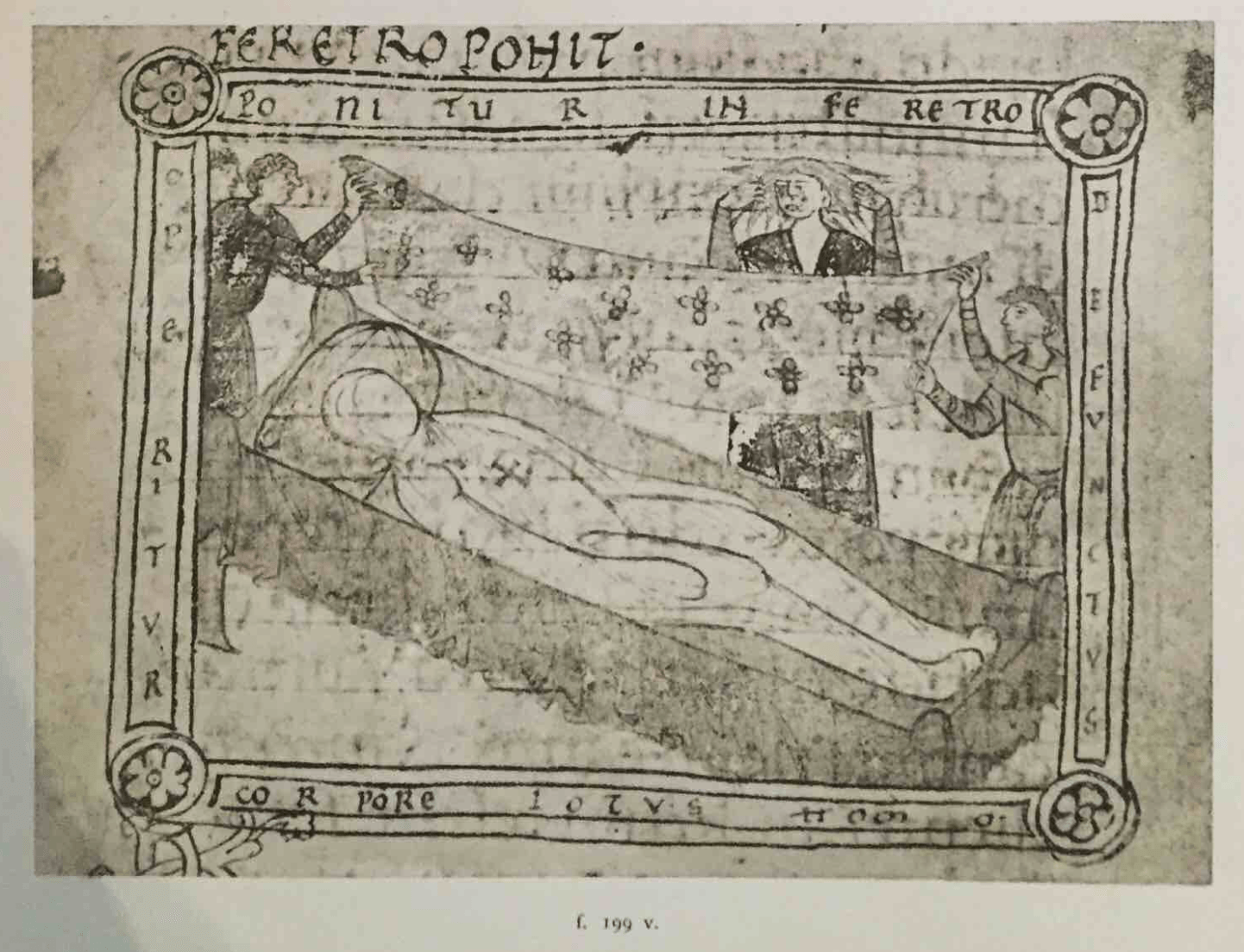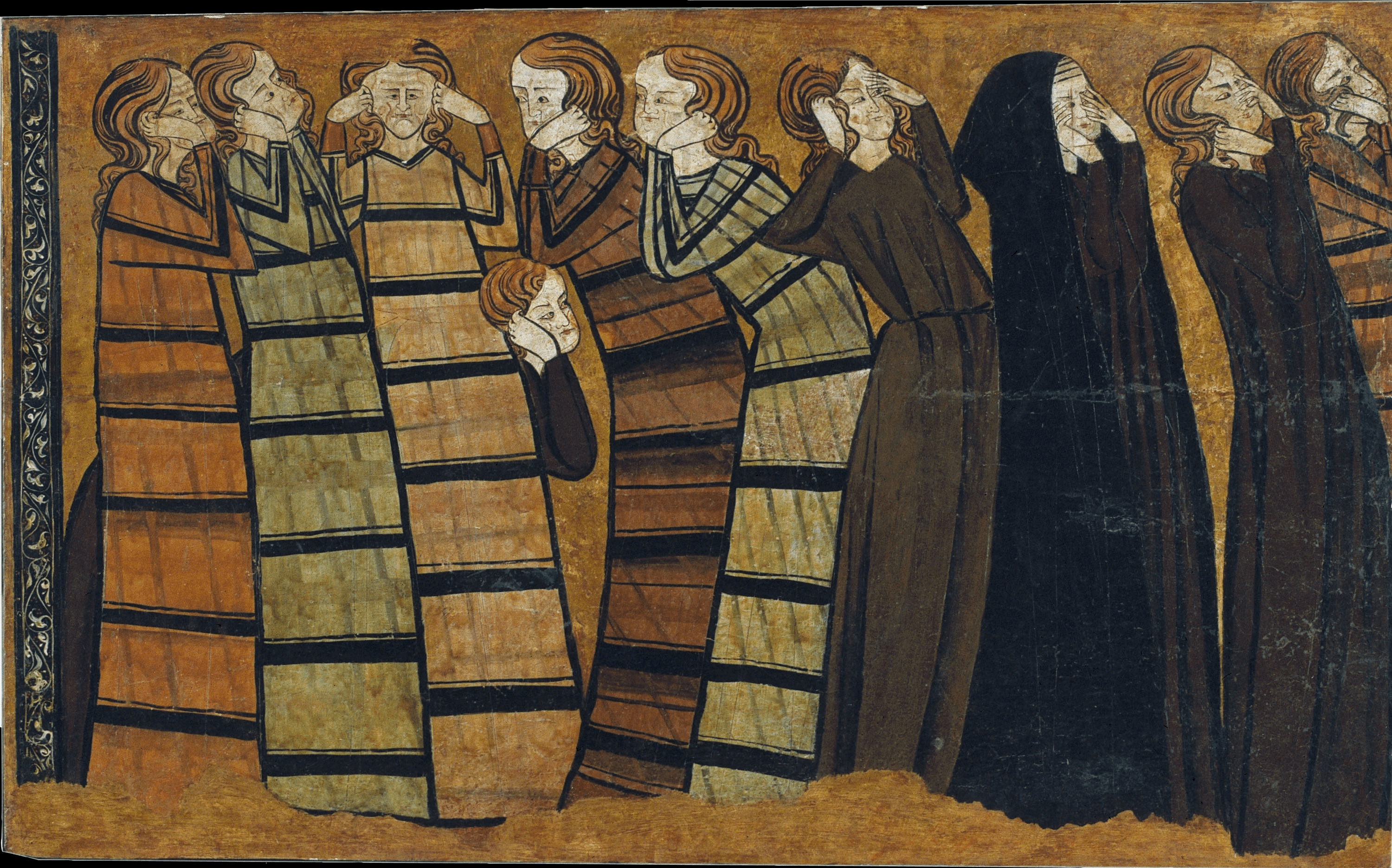by guest contributor Rachel Q. Welsh
In medieval Castile, between about 1050 and 1300, local municipal lawcodes, or fueros, looked to the body for proof of rape. These fueros provided detailed and practical sets of laws and privileges to newly founded or conquered towns before the advent of centralized royal law, and they were intended to encourage settlement and establish civic order on the expanding Castilian frontier. Although the fueros set harsh penalties for rape, a valid claim hinged on the woman’s own actions of public self-mutilation. In order to prove rape, a woman had to appear publicly within three days of the assault and rend her cheeks, tearing at her face with her fingernails until it bled. If the woman did not appear carpiendo y rascando, “tearing and scratching,” she was not to be believed, according to texts like the Fuero de Alba de Tormes.

Woman mourner, sacramentary of Ivrea, c. 1000, Northwest Italy. Biblioteca Capitplare d’Ivrea, codex 86, f. 199 verso. Miniatures reproduced in Luigi Magnani, Le miniature del sacramentario d’Ivrea e di altri codici Warmondiani. Codices ex Ecclesiasticis Italiae Bybliothecis Delecti, Phototypice Expressi (Città del Vaticano: Biblioteca Apostolica Vaticana, 1934), tav. XXXVII.
 The physical action of cheek rending is not unique to these Iberian lawcodes, as it was also part of a larger Mediterranean practice of ritual mourning, in which mourners raised loud laments and tore their hair, faces, and clothing.
The physical action of cheek rending is not unique to these Iberian lawcodes, as it was also part of a larger Mediterranean practice of ritual mourning, in which mourners raised loud laments and tore their hair, faces, and clothing.These self-mutilating actions were especially associated with women, however, and women’s mourning bodies were understood within a framework that linked bodily expressions of emotion with unrestrained sexuality and self-mutilation. For example, John Chrysostom suggested in a homily that women tore their bodies and clothing not to demonstrate grief, but to show their bodies and attract lovers. Because Iberian women tore their cheeks both as part of ritual mourning and as proof of rape, however, what little scholarship mentions cheek rending as proof usually explains it away in terms of grief and emotion: Distraught women tore their faces in grief at the shame and dishonor of rape. While this could explain why an individual woman might rend her cheeks, it does not explain why the legal system would require torn and bleeding cheeks as proof.
In thinking about cheek rending as proof of rape, I propose that we think of it first as a real, physical action, not just as a ritual or cultural performance. The municipal fueros themselves are very practical legal codes, without overt ideological goals; they deal with everyday life on the Castilian frontier, and they regulate such mundane things as which days Jews and Christians could use the bathhouses or how bakers should be fined for heating their public bread ovens badly. The stipulations on rape and cheek rending should be read within this straightforward framework. The verbs used in Latin and Romance to refer to cheek rending—including rascar, grafinar, mesar, carpir, desfacer, cortar—signify real physical violence; the mourners scratch, rip, tear, cut, and strip their faces. The thirteenth-century Primera Crónica General describes women mourners as tearing and scratching their faces (tornandolas en sangre et en carne biva), stripping them back to blood and to open wounds. Alfonso X’s great royal legal code, Las Siete Partidas, condemns excessive mourning and refers to cheek rending as disfiguring. Moreover, it forbids priests from administering the sacraments to mourners until they had healed from the marks they had made on their faces. This suggests that cheek rending left real visible marks on mourners’ faces, that their bodies were literally marked, and possibly even scarred, with grief. Images of mourners rending their cheeks bear this out, as many show bloody red lines on the mourners’ faces. A medieval medical text on treatments for women, included in the Trotula collection, even describes an ointment which the women of Salerno used to treat the marks on their faces which they made in mourning for the dead (contra maculas in facie quas faciunt salernitane pro mortuis). If women tore their cheeks both in mourning and in rape, would widows and raped women then have the same facial marks or scars?

Scene of mourning at an honorable death, with women rending their cheeks, late 13th century Castile. From Cantiga 152, Cantigas de Santa Maria. Image reproduced in Heath Dillard, Daughters of the Reconquest: Women in Castilian Town Society, 1100-1300 (Cambridge: Cambridge University Press, 1984), plate 20.
Because cheek rending was a bodily action performed through real, bleeding bodies, I further suggest that any examination of cheek rending as proof of rape should consider larger questions of how bodies, and especially women’s bodies, functioned before the law. Scholarship on emotion and gestures suggests that weeping was seen as a sign of sincerity, and cheek rending as proof of rape suggests a similar connection between outward appearance and internal mental state. The definition of rape in the fueros hinges on intent, consent, and believability, and in many fueros the cheek rending requirement falls under the heading “What woman should be believed concerning rape[?]” (Qual mugier deue seer creyda por forçada). Cheek rending might actually go further than just proving intention and sincerity, however, as many of these same towns also used the ordeal of hot-iron and the physical bodies of women to prove guilt or innocence. This ordeal was used only with women and only with women accused of certain kinds of bodily, secretive crimes, including poisoning, abortion, prostitution, and witchcraft. For these crimes, the law bypassed the woman’s testimony to access the truth directly from her body.

Mourners tearing their hair and faces in grief, c. 1295, Castile. 1 of 8 wooden panels originally in the chapel of San Andrés de Mahamud (Burgos). The Plañideros panels are currently in Sala 19 of the Museu Nacional d’Art de Cataluyna, in Barcelona, catalog numbers 004372-003, 004372-004, 004372-005, and 004372-006.
But why only women’s bodies? If men were dishonored, they proved their civil cases through character witnesses and testimony, not through self-mutilation and bleeding cheeks. I am only beginning sustained research, but I suspect that there’s something about the body itself, an understanding that bodies – and especially female bodies, which were seen as more material and less spiritual than male bodies – could somehow demonstrate truth. In cheek rending as proof of rape, women mark and even mutilate their bodies to make visible the internal violence and dishonor of rape; in ordeal, perhaps, the body speaks for itself.
Rachel Welsh is a doctoral candidate in Medieval History at New York University. Her dissertation focuses on ordeal and the use of the body as legal proof in medieval Iberia, and she is interested more broadly in medieval medical, theological, philosophical, and legal understandings of the body as a potential conduit of truth.



September 21, 2016 at 1:42 pm
This was a very interesting read! Thank you.
September 26, 2016 at 7:53 am
I’m not sure that this is what John Chrysostom actually said or meant. Adding a “might” and “perhaps” would make the statement more accurate. Other than that, in a Mediterranean Medieval context, the suggestion that some women would use a social gathering as opportunity to attract a suitor doesn’t seem particularly unrealistic.